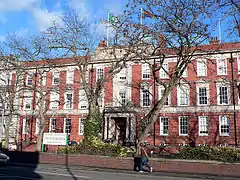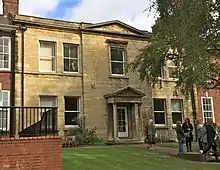County Offices, Lincoln
The County Offices is a municipal building in Newland, Lincoln in the county of Lincolnshire in England. It is the headquarters of Lincolnshire County Council.
| County Offices, Lincoln | |
|---|---|
 County Offices | |
 County Offices Location within Lincolnshire | |
| General information | |
| Architectural style | Neo-Georgian style |
| Address | Lincoln, Lincolnshire |
| Country | United Kingdom |
| Coordinates | 53.2313°N 0.5457°W |
| Completed | 1932 |
| Design and construction | |
| Architect | Scorer and Gamble |
History

In the late 19th century and early 20th century meetings of Lindsey County Council were held at County Hall, Lincoln Castle.[2] After deciding the old county hall was inadequate for their needs, county leaders chose to procure a new county headquarters: the site selected they selected was the substantial grounds of a house known as Newland House which had been designed by William Hayward in the classical style and completed in 1824.[1] Council officials purchased the estate from the executors of the local coal merchant, William John Warrener.[3][4][lower-alpha 1]
Construction started with the demolition of everything except the original facade of Newland House in 1926.[6] The new building was designed by Scorer and Gamble in a Neo-Georgian style and was officially opened by the chairman of the county council, George Edward Heneage, 2nd Baron Heneage, in 1932.[3][7][8]
The new structure was built around two quadrangles. The first phase was the northern facade and quadrangle (which incorporated the original facade of Newland House)[lower-alpha 2] and the second phase was the southern facade and quadrangle which was built with red brick and innovative concrete dressings.[9] The third phase involved inserting an Art Deco staircase into Newland House.[10]
The design for the main building involved a symmetrical main frontage with fifteen bays facing onto Newland with the end bays slighted projected forwards; the central section featured a portico with paired Doric Order columns and balustraded parapet; there were sash windows on the first and second floors with a stone surround which extended to both floors. Internally, the principal room was the council chamber.[11] Pevsner described the building as "all somewhat dry and academic".[9]
Following the implementation of the Local Government Act 1972,[12] the building became the headquarters of the newly-created Lincolnshire County Council in 1974.[1]
Notes
- Warrener's son was the artist, William T. Warrener, best known for being the subject of his friend Henri de Toulouse-Lautrec's painting L'Anglais au Moulin Rouge (The Englishman at the Moulin Rouge) (1892).[5]
- The design of Newland House involved a symmetrical main frontage of five bays facing south; the central bay, which slightly projected forwards, featured a porch with Doric order columns, a sash window on the first floor and a pediment at roof level.[1] In the mid-1970s the chief executive of the county council sat in the large room behind the facade, but it was subsequently occupied by the legal department.[3]
References
- Historic England. "House front incorporated in Lincolnshire County Council Offices (1388719)". National Heritage List for England. Retrieved 8 September 2019.
- "Lindsey County Council". Sheffield Daily Telegraph Yorkshire, England. 29 July 1905. Retrieved 2 October 2019.
- Wheatley, Pearl. "Newland House" (PDF). Lincolnshire Past and Present Issue 92 Summer 2013. Society for Lincolnshire History and Archaeology. p. 13. Retrieved 17 October 2020.
- "No. 23734". The London Gazette. 5 May 1871. p. 2218.
- Thomson, R.. 'Representing Montmartre', pp. 225-79, in, Thomson, R., Friches-Thory, C., &, Roquebert, A., (ed.), Toulouse-Lautrec, (Yale University Press, New Haven and London, 1991), p. 264-65
- "Lincoln Townscape Assessment: Orchard Street Inherited Character Area Statement" (PDF). City of Lincoln. Retrieved 17 October 2020.
- "The early history of Lincolnshire County Council Offices, Newland, Lincoln". Lincolnshire Past and Present Issue 108 Summer 2017. Society for Lincolnshire History and Archaeology. Retrieved 14 November 2020.
- Walford, Edward (2018). The county families of the United Kingdom; or Royal Manual of the Titled and Untitled Aristocracy of Great Britain and Ireland. Forgotten Books. ISBN 978-0265821886.
- Antram, N.; Pevsner, N.; Harris, J. (1989). The Buildings of England: Lincolnshire. Penguin Books; reissued by Yale University Press. p. 504. ISBN 0300096208.
- Lincoln City Building applications. 6219, 8 February 1926; 6863 18 November 1930, 7136, 21 August 1933
- "Grantham people can question county council leaders on their budget". Grantham Journal. 14 December 2015. Retrieved 17 October 2020.
- Local Government Act 1972. 1972 c.70. The Stationery Office Ltd. 1997. ISBN 0-10-547072-4.